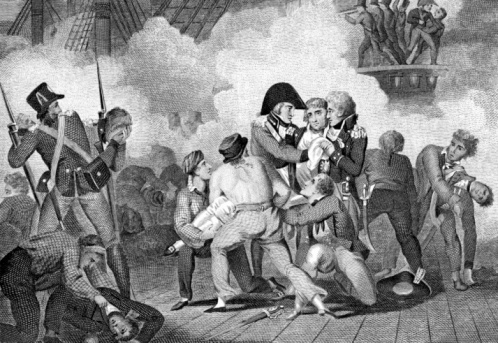This month in history: The funeral of Lord Horatio Nelson
On 21 October 1805, Horatio Nelson died during the Battle of Trafalgar. As part of our ‘This month in history’ series, we look at his funeral at St Paul's Cathedral on 9 January 1806.

The death of Horatio Nelson
Lord Nelson died in battle off the south-west coast of Spain on 21 October 1805 during the Battle of Trafalgar. While on board HMS Victory with his flag captain Thomas Hardy, he took a bullet from a French musketeer sometime around 1.15pm. Fatally wounded, Nelson died just before 4.30pm.
There has been some debate as to the last words of Nelson; however, at least three surviving witnesses stated that he said: “Kiss me, Hardy”. To which Hardy obliged, kneeling and kissing his Commander in Chief on the cheek. According to the same eyewitnesses, Nelson then uttered his last words: “Thank God, I have done my duty.”
The Gazette documented the efforts of Nelson, Hardy and the British fleet during the Napoleonic wars with an Extraordinary edition on 6 November 1805 (Gazette issue 15858). Publishing Vice-Admiral Cuthbert Collingwood’s despatch from the Battle of Trafalgar in full, it read: “The ever to be lamented Death of Lord Viscount Nelson, Duke of Bronte, the Commander in Chief, who fell in the Action of the Twenty-first, in the Arms of Victory, covered with glory.”
Following his death, Nelson’s body was placed in a cask of brandy mixed with camphor and myrrh for preservation and transported to Gibraltar on HMS Victory. Arriving on 28 October 1805, the body was transferred to a lead-lined coffin which was filled with spirits of wine. News of Nelson’s death reached London when Collingwood's despatches about the battle were carried aboard the HMS Pickle.
Lord Nelson’s body arrived at Greenwich Hospital on 23 December 1805, and from 5 January 1806 it lay in state in the Painted Hall for three days. More than 15,000 people came to pay their respects, with many more turned away due to overcrowding.

The funeral of Horatio Nelson
Horatio Nelson’s funeral took place at St Paul’s Cathedral on 9 January 1806. The Gazette published a detailed account of the proceedings on Tuesday 14 January 1806 (Gazette issue 15881).
According to The Gazette, on 8 January: “the Remains of the late Right Honorable Horatio Viscount and Baron Nelson, K. B. Vice-Admiral of the White Squadron of His Majesty's Fleet, were conveyed from the Royal Hospital of Greenwich […] to the Admiralty.” His body was accompanied by four mourning barges on a procession on the River Thames. Located in the third barge, his body was “Covered with a large Sheet, and a Pall of Velvet adorned with Six Escocheons.”
On Thursday 9 January, a funeral procession began from the Admiralty at 11 o’clock and headed to St Paul's Cathedral. It consisted of 32 admirals – one of which was “Chief Mourner” Sir Peter Parker, Admiral of the Fleet – over 100 captains and an escort of nearly 8,000 soldiers. Over 20,000 volunteers were also employed in lining the streets. The funeral car was "decorated with a carved imitation of the head and stern of His Majesty's Ship the Victory, surrounded with escutcheons of the arms of the deceased, and adorned with appropriate mottos and emblematical devices."
The service itself lasted some four hours. During it, the likes of Thomas Attwood Walmisley’s the ‘Magnificat’ and Maurice Greene’s ‘Lord, Let Me Know Mine End’ were sung, as well as Handel’s ‘Their Bodies are Buried in Peace’. Nelson’s coffin was lowered into an ornate tomb in the crypt at St Paul’s.
It had been intended that the service ended with sailors folding and placing a union flag from HMS Victory into Nelson’s grave; however, large parts of it were torn into pieces by the sailors who wanted to keep a memento of the occasion. Some of the surviving fragments are in private collections, while many can be found in various museums.
Summarising the funeral of Nelson, The Gazette supplement concluded: “During the Whole of this solemn Ceremony, the greatest Order prevailed throughout the Metropolis and, as the Remains of the much-lamented Hero proceeded along, every possible Testimony of Sorrow and of Respect was manifested by an immense Concourse of Spectators of all Ranks.”
See also
This month in history: Battle of Trafalgar
This month in history: Edward VIII abdication crisis
Publication date: 8 January 2020
